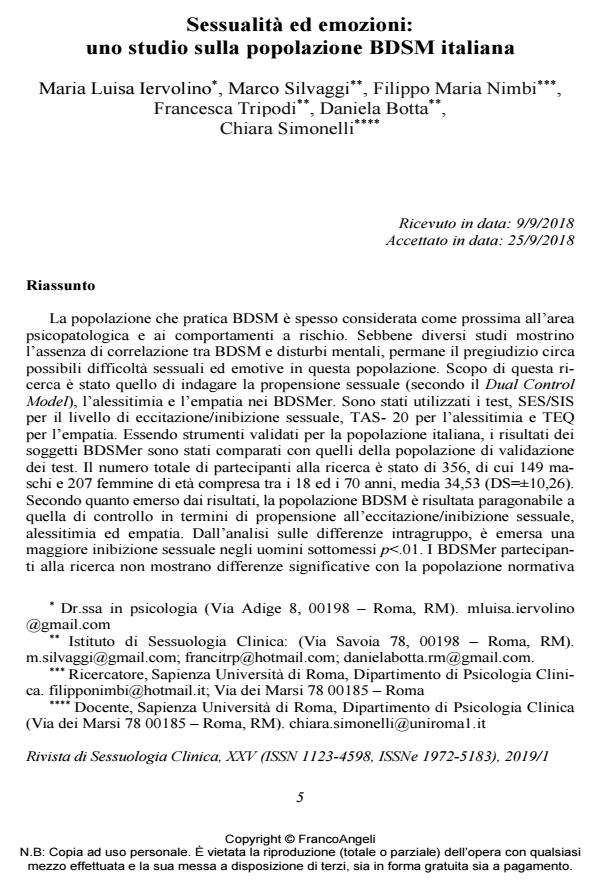Sexuality and emotions: a study on BDSM Italian population
Journal title RIVISTA DI SESSUOLOGIA CLINICA
Author/s Maria Luisa Iervolino, Marco Silvaggi, Filippo Maria Nimbi, Francesca Tripodi, Daniela Botta, Chiara Simonelli
Publishing Year 2019 Issue 2019/1
Language Italian Pages 26 P. 5-30 File size 403 KB
DOI 10.3280/RSC2019-001001
DOI is like a bar code for intellectual property: to have more infomation
click here
Below, you can see the article first page
If you want to buy this article in PDF format, you can do it, following the instructions to buy download credits

FrancoAngeli is member of Publishers International Linking Association, Inc (PILA), a not-for-profit association which run the CrossRef service enabling links to and from online scholarly content.
The population of people that engages in BDSM activities (acronym that stands for Bondage, Discipline, Sadism and Masochism) has often been consid-ered, from mainstream culture, close to the psychopathological area; has also been connected with the incapacity of controlling sexual instincts, risk behaviors, up to, in some extreme cases, violence and consent violations. Although some new national and international studies showed the lack of correlation between BDSM activities and mental disorders, the prejudice regarding the possible sexual and emotional difficulties related to this population can often remain. The main focus of this research was to investigate the sexual propensity, the level of alexithymia and empathy into an Italian sample of people that engages in BDSM activities. As a reference model to assess the sexual propensity has been used the Dual Control Model, which hypothesizes that sexual excitation and behaviors connected to that depends on the balance between sexual excitation and inhibition inside our brains. Alexithymia can be described as a general difficulty of identifying feelings and discriminating one from another, of distinguishing emotions from feelings coming from non-emotional somatic alterations, of a certain level of difficulty in com-municating feelings to others. It is also characterized by a stimulus-related cogni-tive style, external oriented, by coerced imaginative processes, with some kind of lack of fantasies. Empathy has been historically defined as the ability to identify yourself in other’s mental state and way of thinking, using the comprehension of their emotional signals, the assumption of their subjective prospective, the ability to share their feelings. The SIS/SES test has been used to assess the level of sexual inhibition/excitation, the TAS-20 test to assess the level of alexithymia, the TEQ test to assess the level of empathy. Since the majority of these instruments has been already validated for the Italian population, results for the BDSM population were compared with those from the validation population of each test. The total number of participants was 356, 149 males and 207 females, with ages going from 18 and 70, and an average of 34,53 years (SD=±10,26). Considering what emerged from the collected data, the BDSM population is comparable with the control sample in terms of sexual excitation/inhibition propensity, alexithymia and empathy. Regarding the intra-group difference analysis, comparing the three sub-groups divided by BDSM role (Dom, Sub, Switch) and gender, a higher level of sexual inhibition emerged in the subgroup of male submissives p<.01. BDSMrs participant to this study don’t show, then, significative differences when compared to the normative population in terms of sexual excitation/inhibition, of the ability of recognizing and expressing feelings to other and empathy. This higher tendency in sexual inhibition from males with submissive role could be explained by the fact that, according to the contemporary cultural perception, submission could be view ad less compatible with stereotypical male sexual identity. During this research da-ta regarding preferences of BDSM activities has been gathered, for example the exclusivity of BDSM-type of sexual encounters, or the possibility to also have non-BDSM relations, sexual and game practices preferred by the participants to the protocol, the possibility of the coexistence of sentimental and Domi-nant/submissive relationships (called D/s). This could be a starting point to further research, with the aim of shedding a light on a population still considered under-ground as the BDMSrs whose fetish and kinky esthetics is getting more and more pervasive in pop culture and mainstream media.
Keywords: BDSM, emotions, sadomasochism, empathy, alexithymia.
Maria Luisa Iervolino, Marco Silvaggi, Filippo Maria Nimbi, Francesca Tripodi, Daniela Botta, Chiara Simonelli, Sessualità ed emozioni: uno studio sulla popolazione BDSM italiana in "RIVISTA DI SESSUOLOGIA CLINICA" 1/2019, pp 5-30, DOI: 10.3280/RSC2019-001001